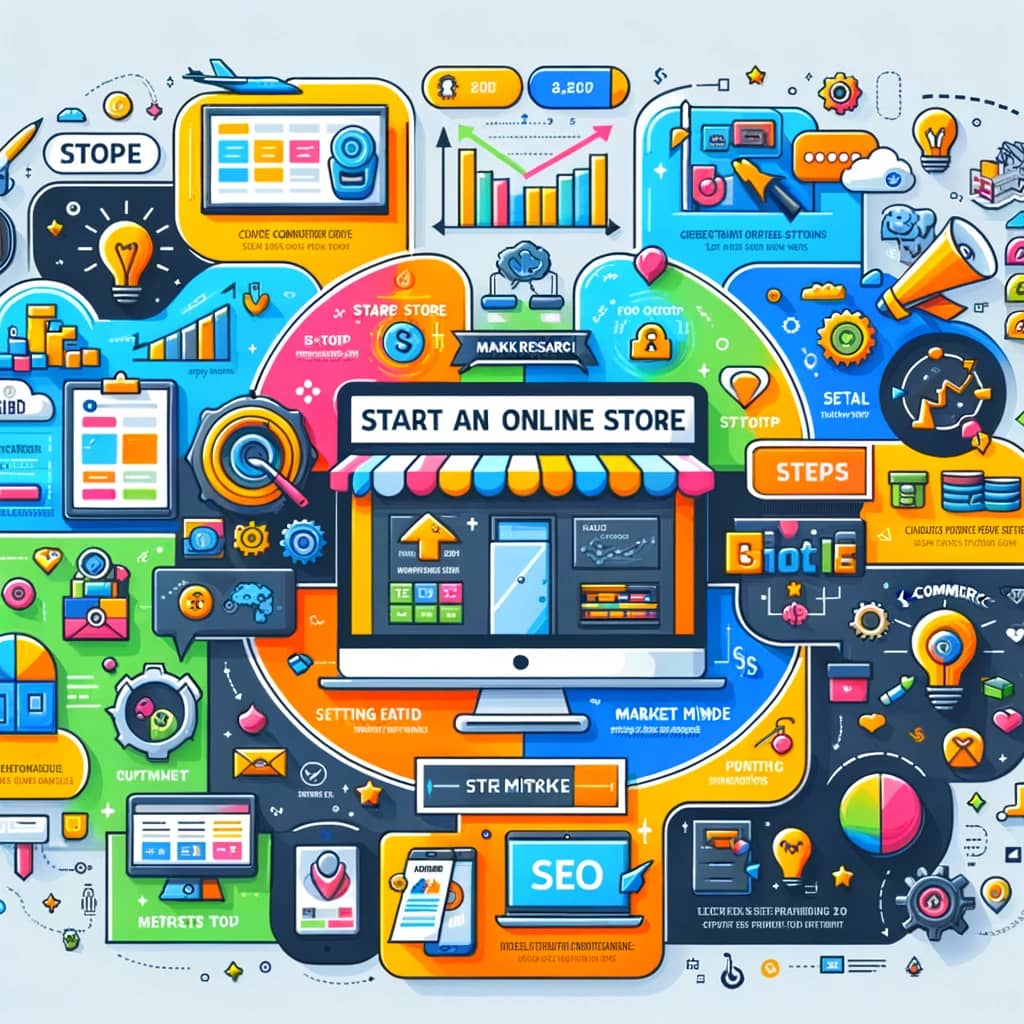Introduction
The digital revolution has transformed the retail landscape, creating a burgeoning e-commerce empire where entrepreneurs can thrive without the traditional storefront. In the last decade, online shopping has not only become a convenience but a necessity, with consumers expecting to find any product or service with just a few clicks. The e-commerce sector’s explosive growth is not just a trend but a shift in how people buy and sell goods and services worldwide.
Starting an online store from scratch might seem daunting, but it’s an accessible dream for many, thanks to modern technology and platforms. The beauty of the internet is its democratization of retail, offering anyone with a vision the tools to build a business from the ground up. Whether you’re a seasoned entrepreneur or a newcomer to the digital marketplace, the journey to launching an online store is filled with opportunities for innovation and growth.

In this comprehensive guide, we’ll walk you through the steps of creating your own e-commerce empire, from conceptualizing your business idea to scaling your operations. By understanding the foundational aspects of online retail and employing strategic planning and marketing, you can carve out your niche in the digital world. So, let’s embark on this journey together, breaking down the process into manageable steps to help you launch a successful online store.
Finding Your Niche
Success in the e-commerce realm often begins with identifying a unique niche that not only interests you but also serves a specific audience’s needs. A well-defined niche helps set your online store apart from competitors and enables you to target your marketing efforts more effectively. Here are strategies to help you pinpoint a profitable niche for your online venture.
Assess Your Interests and Expertise
Starting a business in an area you’re passionate about can be a significant advantage. It ensures you remain motivated, especially when faced with challenges. Consider your hobbies, professional skills, and areas of expertise. An online store that aligns with your interests is more likely to sustain your enthusiasm over time.
Research Market Demand
Understanding market demand is crucial for selecting a niche. Utilize tools like Google Trends and keyword research tools to analyze the popularity and seasonality of potential niches. Additionally, exploring social media platforms and forums can provide insights into what consumers are discussing and the products they’re seeking.
Analyze the Competition
While a niche with little to no competition may seem attractive, it can often indicate a lack of demand. Conversely, extremely competitive niches might be difficult to break into. Aim for a balance by choosing a niche with moderate competition, signifying a healthy demand. Use e-commerce platforms to see how many businesses are selling within a specific niche and what differentiates the successful ones.
Consider Profitability
Finally, your niche should be financially viable. Assess the potential profit margins of your products, considering factors like sourcing, production costs, and pricing strategies. Some niches might have higher upfront costs but offer substantial long-term profitability due to high demand and customer loyalty.
Example: Eco-Friendly Home Goods
As an example, the eco-friendly home goods market has seen significant growth. Consumers are increasingly conscious of their environmental impact, seeking sustainable alternatives for everyday products. This niche is broad enough to allow for a diverse product range yet specific enough to target environmentally conscious consumers. With the right approach to sourcing and marketing, this niche can offer substantial profitability and room for growth.
By meticulously analyzing your interests, market demand, competition, and profitability, you can identify a niche that not only resonates with you but also holds the promise of a successful online store.

Planning Your Business
A well-thought-out plan lays the groundwork for your e-commerce venture, detailing the path from idea to execution. This section explores the essential components of planning your online business, ensuring you’re prepared for success.
Defining Your Business Model
The first step in planning your business is to define your e-commerce model. Will you be dropshipping, holding inventory, or perhaps offering digital products or services? Each model has its benefits and challenges. Dropshipping can minimize upfront costs and risks associated with inventory management, but it often comes with lower profit margins and less control over shipping times. On the other hand, holding inventory requires more initial investment but allows for better quality control and faster shipping, potentially leading to higher customer satisfaction.
Legal Considerations and Business Registration
Navigating the legal aspects of starting an online business is vital. Depending on your location, this may involve registering your business, obtaining necessary licenses or permits, and understanding tax obligations. It’s essential to decide on a business structure (such as sole proprietorship, partnership, LLC, or corporation) as this will impact your taxes, liability, and the way you can raise capital. Consulting with legal and tax professionals can provide guidance tailored to your situation, helping you avoid future complications.
Crafting a Business Plan
Your business plan is a comprehensive document that outlines your business goals, target market, competition, marketing and sales strategies, financial projections, and operational plan. It should clearly articulate how you intend to achieve your business objectives and the steps required to get there. This document is crucial not only for guiding your strategy but also for securing financing or investment, as it demonstrates your business’s potential for success to banks or investors.
A robust business plan includes:
- Executive Summary: An overview of your business idea, mission statement, and the products or services you will offer.
- Market Analysis: Insights into your target market, customer needs, and competitive landscape.
- Organization and Management: Your business structure, management team, and operational workflow.
- Marketing and Sales Strategy: How you plan to attract and retain customers, including pricing, promotion, and distribution channels.
- Financial Plan: Detailed projections for startup costs, revenue, expenses, profit margins, and cash flow analysis.
Example: Online Store for Handcrafted Jewelry
Consider an online store specializing in handcrafted jewelry. The business model might focus on creating unique, customizable pieces, selling directly to consumers through an e-commerce platform. Legal steps would include registering as an LLC to protect personal assets and obtaining a seller’s permit. The business plan would detail the niche market of eco-conscious consumers looking for sustainable jewelry options, outline a marketing strategy leveraging social media and influencer partnerships, and include financial projections based on material costs, pricing strategies, and initial marketing expenses.
Planning your business meticulously ensures that you’ve considered all critical aspects of your online store, from operational logistics to legal compliance and financial sustainability. This foundation is essential for building a successful e-commerce empire.

Setting Up Your Online Store
Creating an engaging and functional online store is critical for attracting and retaining customers. This part of the process involves choosing the right platform, designing your store, and populating it with your products. Each of these steps plays a crucial role in the success of your online business.
Choosing the Right E-commerce Platform
The foundation of your online store is the e-commerce platform you choose. Options range from fully hosted solutions like Shopify and BigCommerce to customizable platforms such as WooCommerce for WordPress. Consider factors like ease of use, scalability, payment processing options, and integration capabilities with other tools and services. For beginners, a hosted platform might be the best choice due to its simplicity and built-in features. However, if you require more control and customization, a platform like WooCommerce might suit your needs better.
Designing Your Store for User Experience
The design of your online store should prioritize user experience (UX). This includes easy navigation, fast loading times, mobile responsiveness, and high-quality product images. An intuitive design guides customers smoothly from browsing to checkout, reducing cart abandonment rates. Incorporate branding elements like your logo, color scheme, and font choices to create a memorable experience. Many e-commerce platforms offer customizable templates, making it easier to achieve a professional look without extensive web design knowledge.
Adding Products and Descriptions
With your store’s structure and design in place, it’s time to add your products. Each product should have a clear, descriptive title, a detailed description, high-quality images, and pricing information. Your product descriptions should highlight the features and benefits of your products, addressing your target audience’s needs and how your product solves their problems. Including customer reviews and ratings can also enhance trust and influence purchasing decisions.
Example: Eco-Friendly Kitchen Gadgets Store
Imagine setting up an online store for eco-friendly kitchen gadgets. After researching, you decide Shopify best fits your needs due to its ease of use and comprehensive features. You choose a clean, minimalist template that reflects your brand’s eco-conscious values, ensuring the site is easy to navigate and mobile-friendly. Each product page features bamboo and stainless steel kitchen tools, with detailed descriptions emphasizing sustainability and durability. High-quality images show the products in use, and customer reviews attest to their effectiveness and environmental benefits.
Creating an inviting and efficient online store is an art and science, blending aesthetic appeal with functionality. By carefully selecting your e-commerce platform, focusing on user experience in your store’s design, and meticulously detailing your products, you set the stage for a successful online business that attracts and delights customers.
Payment Processing and Logistics
The backbone of any e-commerce store is its ability to process payments securely and manage the logistics of inventory, shipping, and fulfillment effectively. Let’s dive into the best practices for setting up these systems.
Setting Up Payment Gateways
Choosing the right payment gateways is crucial for your online store. You want to offer customers a variety of payment options, including credit cards, PayPal, and possibly even digital wallets like Apple Pay or Google Wallet. This flexibility can improve the checkout experience and potentially increase sales. Security is also paramount; ensure that your chosen payment processors comply with the Payment Card Industry Data Security Standard (PCI DSS). Many e-commerce platforms offer integrated payment solutions, simplifying this process. However, it’s worth comparing transaction fees as these can vary and impact your margins.
Managing Inventory
Effective inventory management ensures that your products are in stock, accounted for, and ready to ship when orders come in. Depending on the scale of your business and whether you hold inventory or dropship, you might need a dedicated system for tracking inventory levels. Many e-commerce platforms include inventory management tools, but for more complex needs, specialized software might be necessary. These systems can help you avoid stockouts and overstocking, manage suppliers, and even forecast demand based on historical sales data.
Shipping and Fulfillment Strategies
Your shipping and fulfillment strategies are integral to customer satisfaction. Consider offering various shipping options, including standard, expedited, and, if feasible, free shipping thresholds. Transparently communicating shipping costs and times can reduce cart abandonment rates. For fulfillment, if you’re not dropshipping, you’ll need to decide whether to handle it in-house or partner with a fulfillment service. Outsourcing can save time and potentially reduce costs, especially if you’re shipping internationally.
Example: Specialty Coffee Beans Store
Imagine you’ve set up an online store selling specialty coffee beans sourced from small farms worldwide. For payment processing, you integrate Stripe and PayPal for their security features and broad customer acceptance. You use Shopify’s inventory management tools to track your bean stock, ensuring you can fulfill orders promptly. Given the importance of freshness in your product’s appeal, you establish a direct relationship with a fulfillment center that specializes in food products, offering customers various shipping options, including next-day delivery for orders within a certain radius of the fulfillment center.
Implementing robust payment processing and logistics systems not only streamlines operations but also enhances the customer experience. By ensuring secure and flexible payment options, maintaining accurate inventory levels, and offering efficient shipping solutions, you’re setting your online store up for success and customer satisfaction.
Marketing Your Store
A comprehensive marketing strategy encompasses various channels and tactics to reach potential customers where they spend their time. From SEO to social media, each element plays a role in building your brand and driving sales.
SEO Strategies for E-commerce
Search Engine Optimization (SEO) is crucial for improving your online store’s visibility in search engine results. Start by researching keywords related to your niche and products, aiming to include them naturally in product descriptions, blog posts, and meta tags. Ensure your website’s structure is search engine friendly, with a clear hierarchy and optimized images. Additionally, creating quality content that addresses your target audience’s needs can attract backlinks, further boosting your site’s authority and ranking.
Social Media and Content Marketing
Social media platforms offer a powerful way to connect with your audience, increase brand awareness, and promote your products. Choose platforms where your target customers are most active, and share engaging content that aligns with your brand’s voice and values. This can include product highlights, customer reviews, and behind-the-scenes looks at your business. Content marketing, through blogging or video creation, can further engage your audience by providing valuable information, entertainment, or solutions to their problems, encouraging them to visit your store.
Email Marketing and Retargeting Campaigns
Email marketing remains one of the most effective ways to communicate with customers and prospects. Collect email addresses through your website with incentives like discounts or valuable content, and use segmented email campaigns to nurture leads, announce new products, or offer exclusive deals. Retargeting campaigns, on the other hand, target users who have visited your site but left without purchasing. Using display ads or social media, you can remind them of the products they viewed, enticing them to return and complete their purchase.
Example: Eco-Friendly Apparel Brand
For an online store specializing in eco-friendly apparel, SEO could focus on terms like “sustainable clothing” and “organic cotton t-shirts.” The brand uses Instagram and Pinterest to showcase their products in lifestyle settings, highlighting their eco-friendly and ethical manufacturing processes. A blog provides insights into sustainable fashion, sharing stories about the sourcing of materials and how to care for eco-friendly garments to extend their life. Email newsletters offer styling tips and exclusive discounts to subscribers, while retargeting ads on social media remind potential customers of the items they considered, emphasizing the brand’s commitment to sustainability.
A strategic, multi-channel marketing approach can significantly enhance your online store’s reach and appeal. By implementing SEO, leveraging social media and content marketing, and engaging customers through email and retargeting campaigns, you can build a loyal customer base and drive sales.
Scaling Your Business
Successful scaling requires a strategic approach, focusing on strengthening your operations, broadening your customer base, and enhancing your product offerings without compromising quality or customer satisfaction.
Analyzing Customer Data for Insights
Data is a valuable asset in understanding your customers’ behaviors, preferences, and purchasing patterns. Tools like Google Analytics can track how users interact with your website, identifying popular products, and pinpointing where you might be losing potential sales. Customer feedback, collected through surveys or reviews, provides direct insights into what customers value in your products and service. Analyzing this data helps you make informed decisions about inventory, marketing strategies, and potential areas for improvement or expansion.
Expanding Product Lines and Entering New Markets
Growth often involves diversifying your product offerings or tapping into new markets. Before expanding your product line, conduct market research to identify trends and customer demands that align with your brand. Testing new products with a limited release can gauge interest before a full-scale launch. Entering new markets might mean targeting a different demographic or expanding internationally. Each step should be taken with a thorough understanding of the new market’s characteristics, including customer preferences, regulatory requirements, and logistical considerations.
Customer Service and Retention Strategies
As your business grows, maintaining high levels of customer service is crucial for retention. Investing in customer support tools and training your team to handle inquiries efficiently can enhance the customer experience. Implementing loyalty programs or offering personalized discounts can encourage repeat business. Additionally, actively seeking customer feedback and showing that you value their opinions can foster a strong community around your brand.
Example: Online Specialty Tea Shop
Consider an online specialty tea shop that has seen steady growth in its customer base. The shop uses analytics to identify popular blends and times of year with increased sales, adjusting inventory and marketing accordingly. Seeing an opportunity, the shop expands its product line to include tea accessories, such as infusers and pots, based on customer interest. To enter the health and wellness market, it introduces a range of herbal teas with targeted benefits, supported by blog content on health topics. The shop enhances customer service by introducing a chat support option and a loyalty program offering rewards for repeat purchases.
Scaling your business is an ongoing process, requiring continuous adaptation and strategic planning. By leveraging customer data, expanding your offerings thoughtfully, and focusing on customer satisfaction, you can sustainably grow your online store, turning it into a thriving e-commerce empire.
Conclusion
Starting an online store from scratch is an ambitious yet attainable goal. By carefully finding your niche, planning your business, setting up your online store, and implementing effective payment, logistics, and marketing strategies, you lay the groundwork for success. As your store grows, analyzing data, expanding your market presence, and enhancing customer service are crucial for scaling your business.
Embarking on this journey requires dedication, adaptability, and a willingness to learn and evolve. However, the rewards of building an e-commerce empire—a business that reflects your passions and meets the needs of a global customer base—are immense. With persistence and strategic action, your online store can flourish, offering both financial rewards and the satisfaction of creating value for your customers.
As we conclude this guide, remember that every successful e-commerce entrepreneur started somewhere. With the right approach, your online store can be the next success story in the digital marketplace.





